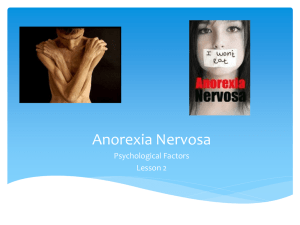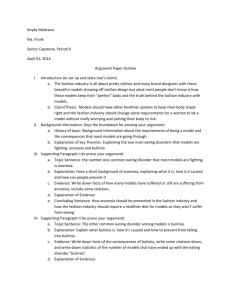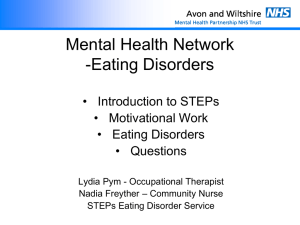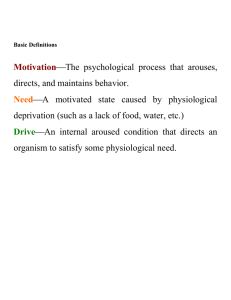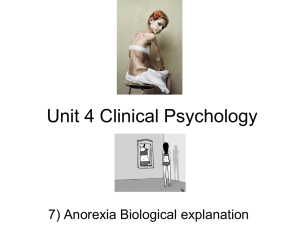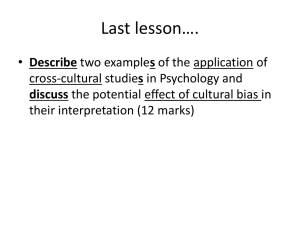Food disorders
advertisement
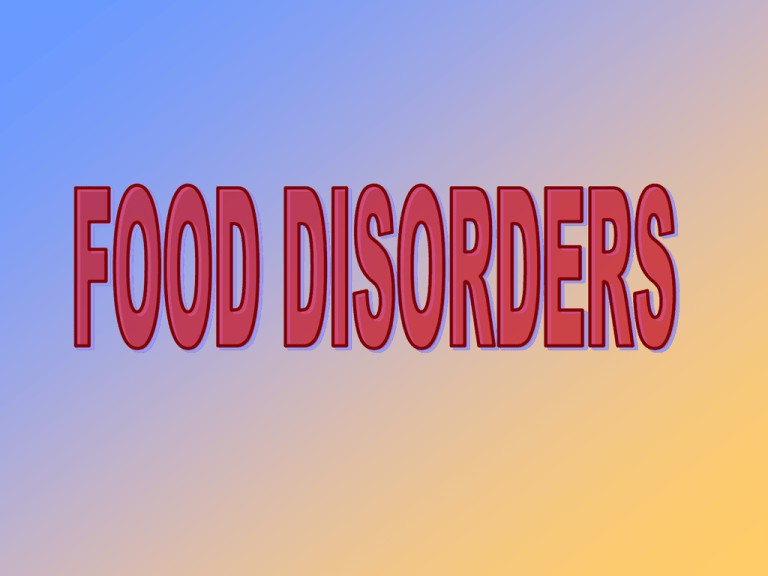
ANOREXIA Anorexia or self starvation was common during the Roman Empire, but seems to disappear in the medieval period when female procreative capability became all important. Charles Lasègue was the first doctor who documented the disease “anorexia nervosa” in 1873, when he wrote L'anorexie Hysterique. His book chronicled the stages of this disease in young French girls. The first published photo of a girl suffering from this disorder appeared in a 1932 issue of the New England Journal of Medicine. The New England Journal of Charles Lasègue The first celebrity that suffered anorexia was the singer Karen Carpenter. Suddenly, following her death in 1983, other actresses and public figures spoke out about their own battles to be thin, and the disease started to be talked about by the media. BULIMIA In the past, people thought that human diseases came from food, so they used to vomit up as a remedy for them. This happened during the middle ages, but also in Ancient Egypt, Greece and Arabian cultures. Emperator Claudius, bulimic. Bulimia during the Ancient Egypt. In ancient Rome this practise was very popular. They even had special places to vomit called "vomitorium". Roman emperors Claudius and Vitellius were bulimic. But bulimia nervosa, as it is presented now, was an unknown disease until the late 20th century. Dr. Gerald Russell was the first one who studied the relation between overeating and self-induced vomiting in normal female students of North American Universities. In 1979 the first description of the modern bulimia nervosa was published. He mentioned that the condition was always most relevant to females. Dr. Gerald Russell DEFINITION ANOREXIA “Anorexia nervosa” is an eating disorder characterized by markedly reduced appetite or total aversion to food. Ii is a serious psychological disorder. The person with anorexia initially begins dieting to lose weight, but finally goes into the endless cycle of restrictive eating, often to a point close to starvation. This becomes an out-of-control obsession and is similar to an addiction to a drug. Anorexia can be life-threatening. ANOREXI A Hospitalization T R E A T M E N T S It could be necessary in case the patient is severely ill. Sometimes those who refuse eating are given feedings through a nasogastric tube. Cognitive – dysfunctional thought patterns, Behavioural attitudes. Psychotherapy Interpersonal Psychotherapy Family Therapy Group Psychotherapy Medications relationship difficulties, selfesteem. Help family change behaviors. While recovering allows people the opportunity to support each others. May help to have fewer depressed Antidepressants feelings, and be less obsessed with food and weight. May help anorexics deal with their anxiety. Tranquilizers They are highly addictive. Estrogens May help some women re-mineralize their bones and avoid them from having fractures in the future. BULIMIA DEFINITION Bulimia is an eating disorder characterized by episodes of excessive eating followed by inappropriate methods of weight control, such as self-induced vomiting, abuse of laxatives and diuretics, or excessive exercise. Like anorexia, this psychological eating disorder goes into an out-of-control dieting. The cycle of overeating and purging can quickly become an obsessive addiction. TREATMENT There are some points that should be worked with a bulimic person to experience a full and succesful recovery: 1. Professional help: to stop the cycle of bingering and purging. 2. Treatement: Phychotherapy to solve the underlying emotional issues that caused the bulimia. 3. Support: friends and family can really help people recover, even when they’re receiving professional advice. Bulimia should never be ignored. SIGNS OF ANOREXIA ♣ ♣ ♣ ♣ ♣ ♣ ♣ ♣ ♣ ♣ Obvious low weight Obsession with overweight Refusal to eat Fear of food or weight gain Over-exercising Hiding food. Unusual eating habits or rituals Distorted body image Personality changes Other behavioral changes PROFILE OF AN ANOREXIC: According to medical data, out of ten patients of anorexia, nine are women, between 15 and 26 years old. They are obsessive, obedient, perfectionist, succesful in their studies and with low self-steem. The girls usually belong to rigid families, strict and little tolerant to changes. Men also suffer this desease. SIGNS OF BULIMIA ♣ ♣ ♣ ♣ ♣ ♣ ♣ ♣ ♣ Worry of over weight Obsession with food/calories and calorie count Hiding food Other means of weight loss (abuse of laxatives, diet, pills…) Signs of vomiting Marks on hand from teeth (from forced vomiting) Fasting Depression Mood changes PROFILE OF A BULIMIC The word bulimia comes from the Greek and means “hunger of oxen”. It only appears generally in people between 18 and 28 years old. They feel guilty after having huge meals so they empty their stomach by different ways. Bulimics are impulsive and conflictive, and they hide the habit of vomiting. Like in anorexia, 95% of bulimic patiens are women. What about celebrities? Poor celebrities! Always in front of the camera, looking perfect everyday and at every moment, they’re just dummies, forced to be always thin. If they put on weight, they’re lost. These are just some examples… -Nicole Richie: This model, actress and singer, due to her anorexia mixed with alcohol and cocaine abuse. She had to enter an anorexia treatment centre because the life of the baby she was going to have was in danger. Mary-Kate Olsen: The famous actress got into an eating disorders treatment center because of her anorexia. This problem appeared when she started to be famous. She wanted a perfect body and in order to get it, she stopped eating. Victoria Beckham: She confessed that in the past she was obsessed with her appearance. Victoria had anorexia and it seems that she hasn’t gone through it yet. Madonna: Six hours of exercise a week and a strict diet have made Madonna suffer anorexia. All in order to let fans see her perfect. As you can see not only ordinary people suffer from these eating disorders, also celebrities do, and they are among the most affected by it, so it isn’t good to follow these examples. What matters is not the image but the inside of the person, the personality of oneself. Enjoy your meals, be healthy, be happy! PUBLICITY You wanna be…???

